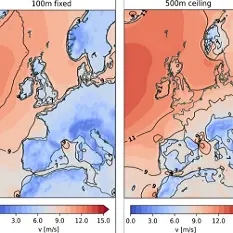Resource Potential and Markets
Coordinator
- TU Delft (Roland Schmehl r.schmehl@tudelft.nl)
- Ghent University (Thomas Haas Thomas.Haas@UGent.be)
Topics and objectives
This work package will assess the high-altitude wind resource, the related generation performance of deployed AWE technologies, both on the system and on the wind park level, as well as the economics and potential contribution of AWE to the future energy system. Several potential scenarios for the global deployment of AWE will be developed to facilitate the formulation of a roadmap for the AWE sector.

These maps show average wind speeds in Europe at typical hub height of wind turbines (left) and at variable altitude of up to 500 m (right)
The following tasks will be covered:
- Assessment of the wind resource (up to ~1 km) using available reanalysis data (e.g. ERA5), regional refinements using appropriate mesoscale model data (e.g. DOWA/new US wind atlas by NREL/GWA3/NEWA), and measurement data (e.g. Lidar data).
- Techniques to simplify the use of the wind resource data and improve its usability (e.g. clustering methods for wind profile shapes) and explore compatible system performance characterizations (e.g. a set of power curves for a variety of wind conditions).
- Performance prediction methods distinguishing different AWES architectures, using low to medium fidelity models to generate power curves, which will then be validated by test data from operational AWES in close collaboration with WP2. The impact of short timescale wind variations and turbulences not covered in the reanalysis data shall be assessed.
- Assessment of the electricity generation potential at selected sites, first for Europe and the US, then for other sites, using the derived wind resource data and AWES power curves.
- Combine performance prediction methods with cost models for specific AWES architectures to explore the system/wind farm design space.
- Embed AWES performance and cost models in an energy system model and investigate the deployment in potential markets, such as on- and off-grid or on- and offshore, considering different penetration scenarios.
Determine economic metrics, such as Levelized costs/profit/revenue of energy (LCOE, LPOE, LROE), etc.
This framework will allow developers to assess how expensive a system is expected to be and how expensive it can be to be economically viable, based on the market. The different stages of model development are systematically interleaved with validation steps, linking also to the reference models of WP2. An optional outcome of the work package is a joint technology assessment approach.
Deliverables
- D1.1 AEP (Annual Energy Production) predictions for selected sites in Europe and US
- D1.2 AEP prediction toolchain documentation
- D1.3 Global high-altitude wind resource atlas
- D1.4 Recommendation on AWE entry-markets
Progress and Achievements
Status November 2022 [Annual Report]:
In WP1 on Resource potential, the wind resource plots for selected sites in Europe and US were refined and improved. The AWE Resource Analysis tool AWERA (https://github.com/awegroup/AWERA) was developed for assessing the potential of AWES on large geographical and temporal scales. The tool uses a clustering technique for vertical wind profiles to substantially accelerate AEP calculations and develop insight into how the vertical wind profile affects energy harvesting.
A reference economic model for airborne wind energy systems is currently being developed as a joint project of TU Delft and Polimi.
Furthermore, a Country Mapping was carried out showing entry-markets for AWE. It contains short information on AWE potential, policies, regulation, stakeholders and opportunities as well as a rating which allows for a quick comparison among countries and for identifying areas to be improved.
